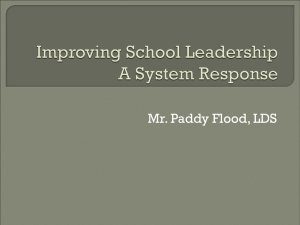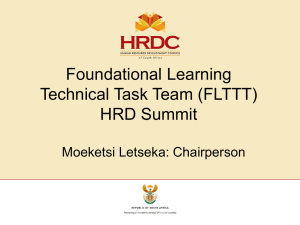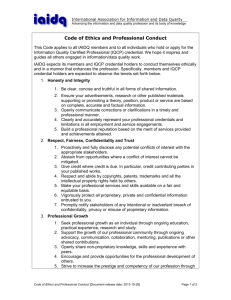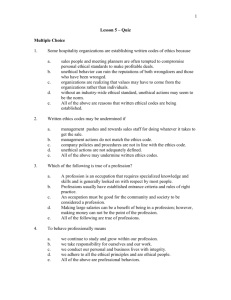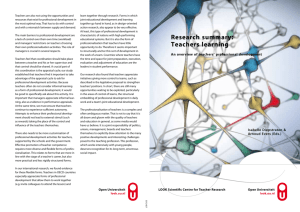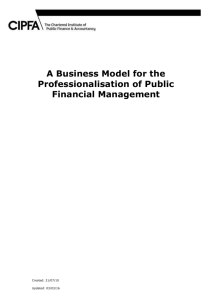Ch 9 Youth work: The professionalisation dilemma
advertisement
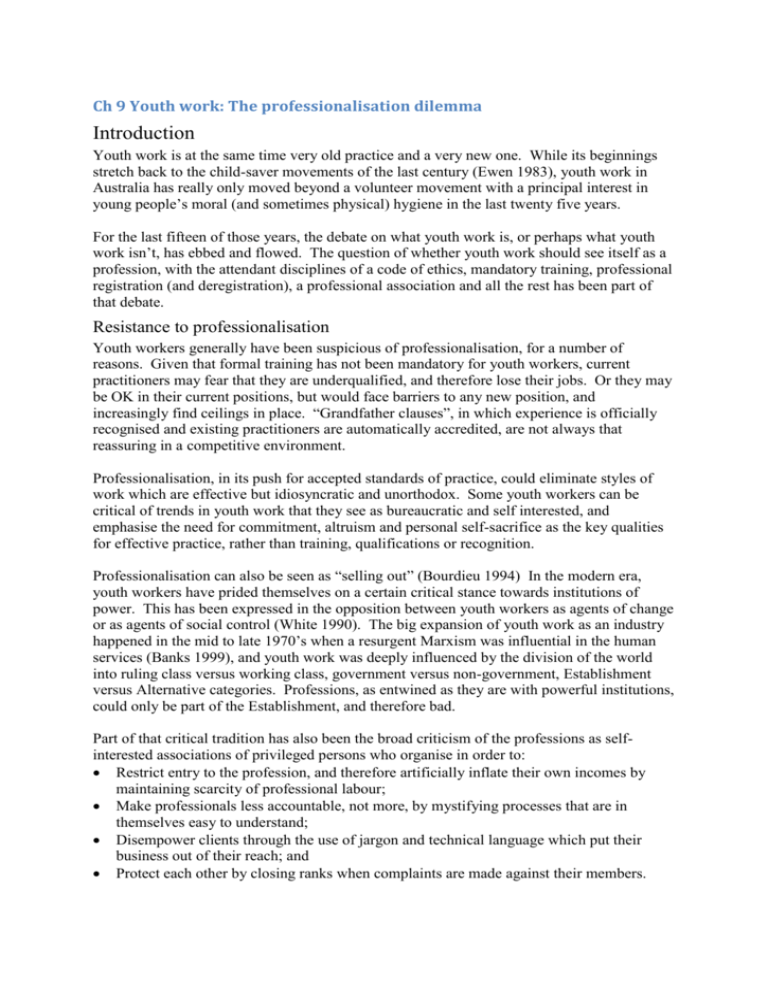
Ch 9 Youth work: The professionalisation dilemma Introduction Youth work is at the same time very old practice and a very new one. While its beginnings stretch back to the child-saver movements of the last century (Ewen 1983), youth work in Australia has really only moved beyond a volunteer movement with a principal interest in young people’s moral (and sometimes physical) hygiene in the last twenty five years. For the last fifteen of those years, the debate on what youth work is, or perhaps what youth work isn’t, has ebbed and flowed. The question of whether youth work should see itself as a profession, with the attendant disciplines of a code of ethics, mandatory training, professional registration (and deregistration), a professional association and all the rest has been part of that debate. Resistance to professionalisation Youth workers generally have been suspicious of professionalisation, for a number of reasons. Given that formal training has not been mandatory for youth workers, current practitioners may fear that they are underqualified, and therefore lose their jobs. Or they may be OK in their current positions, but would face barriers to any new position, and increasingly find ceilings in place. “Grandfather clauses”, in which experience is officially recognised and existing practitioners are automatically accredited, are not always that reassuring in a competitive environment. Professionalisation, in its push for accepted standards of practice, could eliminate styles of work which are effective but idiosyncratic and unorthodox. Some youth workers can be critical of trends in youth work that they see as bureaucratic and self interested, and emphasise the need for commitment, altruism and personal self-sacrifice as the key qualities for effective practice, rather than training, qualifications or recognition. Professionalisation can also be seen as “selling out” (Bourdieu 1994) In the modern era, youth workers have prided themselves on a certain critical stance towards institutions of power. This has been expressed in the opposition between youth workers as agents of change or as agents of social control (White 1990). The big expansion of youth work as an industry happened in the mid to late 1970’s when a resurgent Marxism was influential in the human services (Banks 1999), and youth work was deeply influenced by the division of the world into ruling class versus working class, government versus non-government, Establishment versus Alternative categories. Professions, as entwined as they are with powerful institutions, could only be part of the Establishment, and therefore bad. Part of that critical tradition has also been the broad criticism of the professions as selfinterested associations of privileged persons who organise in order to: Restrict entry to the profession, and therefore artificially inflate their own incomes by maintaining scarcity of professional labour; Make professionals less accountable, not more, by mystifying processes that are in themselves easy to understand; Disempower clients through the use of jargon and technical language which put their business out of their reach; and Protect each other by closing ranks when complaints are made against their members. Or, as George Bernard Shaw once said, “every profession is a conspiracy against the laity” (Koehn 1994). Finally, youth workers have proved resistant to being organised. Used to high degrees of autonomy and the need to exercise initiative, they are not always good followers. As a colleague dryly observes, organising youth workers is like herding cats. In Australia at least, youth workers have low rates of membership in trade unions, even though they would be strong advocates of trade union membership for their clients. There is an enormous variety of contexts for practice, personal and professional ideologies, and organisational structures which makes the establishment of common action difficult. The demand for professionalisation At the same time, youth workers are starting to murmur about incidents and practice they come across which raise the question of professional practice. Workers continue to report a range of practices which claim to be youth work, but do not measure up to practicing youth workers’ expectations of credible practice. These include things such as street evangelism, pure recreation programmes or “keeping them off the streets”, the involvement of youth workers in curfews and other street-clearing exercises, the employment of “youth workers” in detention centres, and their involvement in processes which may be against the interests of the young person concerned, such as the breaching provisions in Mutual Obligation and Work for the Dole programmes. It is hard to see how the young person is your primary client when you have just cut them off their income for missing an appointment. Youth workers continue to be marginalised in professional teams, in professional consultations, or case management panels because their professional standing is not recognised by other professionals. Their knowledge and expertise is frequently dismissed, limiting their capacity to advocate effectively for their clients. There are some agencies that hire psychology or social work graduates for what are ostensibly youth work positions because their professional accreditation gives some guarantee of standards of practice, or at least some recourse if standards are breached. Institutional employers such as schools, conscious of public accountability, remain cautious about engaging youth workers in the absence of professional recognition. The problem solving and advocacy skills of youth workers are therefore denied to young people in the very context where they would appear to be most needed. Examples of seriously unethical practice continue to filter through. The grapevine, and occasionally the courts, continues to pass on stories of youth workers selling drugs to young people, having sex with them, sharing pornographic videos, buying electronic goods from young people, embezzling agency funds, “permanent loans” of electronic, sporting or camping equipment to workers, using agency funds for home renovations, turning up for work drunk or stoned, and giving police access to young people’s files. Less overt questions have been raised about workers giving themselves hefty pay increases at the expense of programmes for young people, or the practice of “creaming”, in which the more “difficult” clients are discouraged or filtered out. These practices remain on the grapevine partly because there is no official process for dealing with them, and because of the increasing use of wrongful dismissal or defamation procedures to prevent their public exposure. Such defences are given weight by the absence of any agreed upon standards for practice or codes of ethics. Pleading ignorance, even in the most obvious cases of unethical practice, is a credible defence in such circumstances. The lack of any professional structure invites the emergence periodically of charismatic messiahs and mavericks, or “kings of the kids”. Proclaiming themselves to be alone in working for the interests of young people, or that their method alone is working, they often gather enthusiastic teams of volunteers who are then over-worked, unpaid, and burn out. Often, of course, the Leader also works very hard, is available 24 hours a day, is deeply committed and has no other life. Usually ignorant or dismissive of other agencies in their field, they can often claim extensive media attention and government support. There is a clear danger, fortunately not always realised, of a “Heart of Darkness” scenario (Conrad 1927), in which the charismatic leader is the sole measure of proper practice and in which things are OK because He says so. The other major incentive for professionalisation has been the growing realisation that Government has been engaged in a long term project to bring the youth work sector (an other sections of the community sector) under governance. There has been an increasing sophistication in government techniques of control over the sector over the last twenty years. Up until the mid 1970’s, government funding was mainly in the form of grants to community organisations to support services proposed and initiated by the community. By the mid 1980’s services were required to submit strategic plans to Government departments, and to evaluate their service according to the plan. Formal funding agreements in the form of a legal contract followed. Finally, services were designed and initiated by governments and put out for tender to the non-Government sector on a payment-for-service basis. Agencies are now effectively agents of Government, still with some scope for autonomous action, but within increasingly prescribed limits. In this context, Governments, especially at the Federal level, have been more and more directive in terms of the way that youth workers do their job. Increasingly, workers are required to exercise punitive action against young people on behalf of governments. Without a clear professional position from which to argue, it is difficult for workers to refuse any line of action on the grounds that it is unethical. Workers or agencies making such a stand are left exposed as lone voices, vulnerable to retaliation or withdrawal of funding. In this environment, youth work doesn’t have a choice about being disciplined. Professionalisation potentially offers an alternative base for discipline, and a foundation for resistance to various government enterprises which may be oppressive to young people or in violation of their civil rights. There have been many examples (such as the position of medical practitioners on supervising the death penalty in the US (Lichtenberg 1996) where professionals have been able to defend themselves against the increasingly coercive demands of government by invoking professional standards. The professionalisation dilemma A number of commentators (Koehn 1994) have drawn attention to the internal ambiguity within the professionalisation question. On the one hand, being a professional indicates an ethical commitment to a client or client group and to a field of action. Doctors commit themselves to the patient, and to the practice of healing. Lawyers commit themselves to the accused or aggrieved, and to the practice of law. Being a professional indicates that the relationship is of a certain kind. It is not a personal relationship, or a commercial one, although aspects of both of these may be implicated. It is at core an ethical relationship, limited in scope (lawyers don’t do brain surgery) but open-ended in the commitment to the client. This is the ethical aspect of professionalisation. On the other hand, the way that the professions have been organised does present opportunities for the advancement of the profession. Basically, any process which effectively disciplines and unites any group of people provides this kind of opportunity, on the principle of “the Iron Law of Oligarchy”: that an organised minority will always prevail over a disorganised majority (Hands 1971). Effectively, professions operate as closed-shop trade unions which operate in the interests of their members. This is what one might call the industrial aspect of professionalisation. The dilemma is that these two aspects can be and often are in conflict. The professions, no doubt originally conceived to protect clients from unscrupulous or unskilled operators, can and have used their collective power to advance their own interests at the expense of clients, whether in escalating fees, restricting entry to the profession to preserve their privilege, resisting reform, or closing ranks to protect their members in the case of external criticism. Professionals’ power is derived from the trust of clients in particular states of vulnerability. Any exercise in which the power derived from a constituency is used to further the interests of the professional at the expense of the constituency is, quite strictly, corruption (Sercombe 1998). The tendency to corruption, no matter how virtuous the original intent, is endemic for the professions, as it probably is for any organised group. It may indeed be inevitable, at least to some degree. However, this is not in itself a convincing argument against professionalisation. It’s not like the youth field, undisciplined, is currently free of corruption or other forms of unethical practice. But at the moment, there are no agreed-upon guidelines for what constitutes unethical practice, no standard upon which to reflect or if necessary, challenge our own practice or that of our colleagues. If the process of professionalisation, for youth work or any of the emerging professions, begins with the industrial aspect, concentrating on the status, wages and conditions of youth workers, the slide into corruption seems very short indeed. If the origin and focus is on the ethical aspect, there may be some chance of mitigating this tendency, and of recognising and correcting it when it appears. Facing the facts The fact is of course that youth work is already a professional practice. While some authors (Greenwood 1957) identify a profession by a list of attributes such as an agreed knowledge base, a code of ethics, mandatory training, a professional association and recognition in law, others (Koehn 1994) argue that these criteria are not essential to professional practice, but are merely mechanisms for institutionalising something more fundamental. At its core, the professional is constituted by a particular kind of relationship with the client (Koehn 1994). It is a relation in which the client is to some extent vulnerable: to sickness, to accusation, to madness. The dimensions of their vulnerability may not be known beforehand, and so the relationship cannot be just a matter of commercial contract: it must be to some extent open-ended. In the light of their vulnerability, the client needs to be able to trust the professional to act in ways that protect them, and which do not exploit the intimacy evoked when people talk about sensitive matters or put themselves into another’s hands. This trust may be based on the individual professional’s reputation or recommendation from others, but more fundamentally rests on the professional’s own public commitment to serve. In these terms youth work is clearly a profession. It is precisely a practice in which clients, at a point of vulnerability, are engaged in an intentionally limited (and therefore safe) relationship directed towards the transformation of their situation. To borrow Marx’s terminology, youth work is a profession “in itself” (it meets all the objective criteria) but not yet a profession “for itself” (self-conscious and aware of its identity and its obligations). Whether or not youth work takes this step to constitute itself as a profession is clearly a matter for debate. It is probably clear from the above discussion that while there are risks, I believe on balance that the time has come. The State of Play Across the world, so it seems, youth work practice is in a similar position: groping towards professionalisation from different directions. In some countries, the process is beginning by constituting professional associations. In others, it is being driven by mandatory minimum standards of training. In others, Government regulation, by law, provides the incentive. In others, the concern with ethics and the drafting of codes of ethics is the issue. For example: In North America, the already well-established professional association (the Association of Child and Youth Care Professionals) is pushing hard towards professionalisation on several fronts, including adopting a code of ethics, national competency standards, professional registration and national minimum training. “Developing and promoting youth work education and training for the professionalisation of the youth sector” is an overt objective of the Commonwealth Youth Programme under its 2003-2006 Strategic Plan (Commonwealth Youth Programme 2003), applicable to all Commonwealth countries. In the UK, youth work has long been organised industrially, and definitions of youth work (in terms of informal social education) and training pathways are well established. However, the development of a code of ethics (National Youth Agency 1999) is of very recent currency. It still has ambiguous status, and hasn’t achieved national adherence. Codes of Ethics have been developed in Wales, Malta, New Zealand, and by international child and youth care bodies including the prestigious Fédération Internationale des Communautès Educatives (FICE). Youth work has recognition in law in several countries, including Finland and Ireland, and in Wales and Scotland (Nicholls 2003). In New Zealand, following the work in Canterbury on a Code of Ethics (based in part on the Fairbridge Code: (Canterbury Youth Workers Collective nd)) a national survey on professionalisation is being driven by the Department of Internal Affairs in partnership with the Canterbury Youth Workers’ Collective. The difficulty in my own setting (Australia), and probably elsewhere, has been the Catch 22 problem of how to organise the profession to ask whether the profession ought to be organised. As a result, progress on resolving the question has been slow. The youth affairs peak organisations are not and probably should not be professional associations, but the advancement of the debate has fallen (often reluctantly) to the peaks. Currently, the peak bodies are working with varying intensity to convene the forums and discussions necessary to move the debate along. Support for a Code of Ethics for youth workers in now widespread: a New South Wales survey cited 80% of youth workers surveyed in favour of a state or national code (Youth Action and Policy Association NSW 2003). The 2003 Western Australian Youth Affairs Conference ratified the Fairbridge Code (reproduced in the Appendix to this article) unanimously and without dissent. Agreed definitions of youth work, framed in terms of the young person as the primary client (Sercombe 1997), are gaining greater currency (Youth Affairs Council of Victoria 2004) and from such definitions, a growing understanding of how youth work is distinguished from other modes of practice that work with young people: including that of parents, police officers, teachers, and social workers. Moves to establish a professional association are current in several Australian states. Conclusion The need for youth workers is not going to go away. Indeed, we are facing an expansion of the youth category from the teenage years into the twenties and thirties, with a whole new series of challenges raised by globalisation, the impact of information and communications technology, and changing patterns of work and education (Sercombe, Omaji et al. 2002). While the involvement of a range of professionals in youth issues and in the care of individual young people is important and necessary, the commitment that youth workers have to the young person as the primary client is an integral part of the picture. If youth workers are unable to find a place where their form of service, knowledge and skills are accepted, young people may continue to find that none of services available to them are unambiguously acting in their interests, and that the information, referral, advocacy and support that youth workers are skilled at delivering continue to be unavailable. Professionalisation will always have its risks. Any profession is prone to corruption, to serving its own interests at the expense of client group. However, we are not in an “aint broke” situation. Ethical problems, lack of clarity, conflict of interest, misrepresentation and lack of discipline are already out there. The choice is not between the innocence of a naïve and undisciplined practice and the organised corruption of the professions. Youth work is no Garden of Eden, and we have seen too many contrary examples over the last twenty five years to claim any innocence for our practice. Rather the choice is between the risk of institutional corruption at the hands of a profession, which can then at least be named and challenged, and the random corruptions of a situation where it is difficult even for it to be named. References Banks, S. (1999). Ethical Issues in Youth Work. London, Routledge. Bourdieu, P. (1994). The field of cultural production. The Polity reader in cultural theory. Cambridge, Polity Press. Conrad, J. (1927). Heart of Darkness. Youth and Two Other Stories. New York, Page & Co. Ewen, J. (1983). Youth in Australia : a new deal and a new role. Melbourne, Phillip Institute of Technology. Centre for Youth and Community Studies, PIT Press. Greenwood, E. (1957). "Attributes of a profession,." Social Work 3(2): 44-55. Hands, G. (1971). "Roberto Michels and the Study of Political Parties." British Journal of Political Science 1: 155-72. Koehn, D. (1994). The ground of professional ethics. London, Routledge. Lichtenberg, J. (1996). What are codes of ethics for? Codes of Ethics and the Professions. M. Coady and S. Bloch. Melbourne, Melbourne University Press: 13-27. Sercombe, H. (1997). "The youth work contract: professionalism and ethics." Youth Studies Australia 16(4): 17-21. Sercombe, H. (1998). "Power, ethics and youth work." Youth Studies Australia 17(1). Sercombe, H., P. Omaji, et al. (2002). Youth and the future: effective youth services in the year 2015. National Youth Affairs Research Scheme. Hobart, Australian Clearinghouse for Youth Studies. White, R. (1990). No space of their own. Cambridge, Cambridge University Press.
